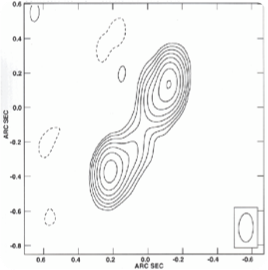Available Data Downloads






Infrared
Radio/Sub-mm
Optical
X-Ray










Far -Infrared




Images, Maps, Spectra and SEDs







Spitzer IRS spectra
PKS0023-26
(Top Left) PKS 0023-263 at 2291 MHz from the SHEVE array. The peak level is 1.07 Jy/beam and contours are shown at -2, -1, 1, 2, 4, 8, 16, 35, 65, 80% of the peak. (Top Right) PKS 0023-263 at 8419 MHz from the SHEVE array. The peak level is 0.41 mJy/beam and contours are shown at -2, -1, 1, 2, 4, 8, 16, 35, 65, 80% of the peak. (Bottom) PKS 0023-263 at 4996 MHz from the MERLIN array. The peak level is 1.41 Jy/beam and contours are shown at -6, -3, -1.5, -0.75, 0.75, 1.5, 3, 6, 12, 24, 48, 96% of the peak.
PKS0023-26
Optical spectrum taken with ESO telescopes. Relatively strong [OII]λ3727 and [NI]λ5199 emission can be seen.

PKS0023-26
Spitzer IRS spectra, strong starburst tracing PAH features can be seen in this mid-infrared spectrum.
Dicken et al. (in preperation)


PKS0023-26
Spitzer MIPS infrared photometric observations. Left to right: 24 microns, 70 microns and 160 microns (when available). FOV are 5x5 arcmins for 24 microns, 5x2.5 arcmins for 70 microns and 0.5x5 arcmins for 160 microns.


N

E
0.322
00 25 49.18
-26 02 12.8
NLRG
CSS
-
Notes
This powerful (log P5 GHz= 27.33 W Hz−1), compact steep spectrum radio source (D = 2.9 kpc: Tzioumis et al. 2002), is identified with an mv= 19.5 galaxy (Prestage & Peacock 1983; Wall & Peacock 1985). The double lobed radio source has a maximum size of ∼680 mas (∼4.25 kpc), aligned along PA −34° (Tzioumis et al. 2002). Spectroscopically it is classified as an NLRG and its emission-line spectrum has intermediate ionization with relatively strong [OII]λ3727 and [NI]λ5199 emission (Tadhunter et al. 1993; Morganti et al. 1997). The optical continuum displays a large UV excess with low UV polarization (P_UV < 2.0 per cent) and no sign of broad permitted lines. Details of the kinematics and ionization of the emission line gas in this source are discussed in Holt et al. (2008, MNRAS, 387, 639) and Holt et al. (2009, MNRAS, 400, 589) respectively.
The host galaxy of PKS0023-26 shares a common envelope with two early-type galaxies at projected distances of 5.8 arcsec (26 kpc) to the NE (C1) and 6.9 arcsec (31 kpc) to the SW (C2). Analysis of our VLT/FORS spectrum along PA51 demonstrates that the companion galaxies have a similar redshift to PKS0023-26 (z_nuc = 0.321955 ± 0.000014), as does a further early-type galaxy 25.8 arcsec (116 kpc) to the NW (C3), which falls within the slit for our PA145 VLT/FORS1 spectra. Based on measurements of the detected Hβ absorption features, the redshifts of C1, C2 and C3 are z_C1 = 0.32499 ± 0.00015, z_C2 = 0.32282 ± 0.00033 and z_C3 = 0.32318 ± 0.00028, corresponding to velocity shifts relative to the rest frame of the nucleus of PKS0023- 26 of +690 ± 34, +200 ± 75 and +280 ± 60 km s−1, respectively. In fact, the field shows several early-type galaxies close (in projection) to PKS0023-26, suggesting that it lies at the heart of a rich cluster of galaxies. However, perhaps the most interesting feature of the image is the extraordinary amorphous structure that lies between PKS0023-26 and its two closest companions. This appears to be crossed by dust lanes, and may comprise regions of active star formation within the extended halo of the galaxy. Although the halo structure is too faint to study in detail with our existing spectroscopic observations, our deep spectrum of the brighter core of the galaxy reveals a YSP with a relatively young age (<0.05 Gyr: Holt et al. 2007). The presence of significant star formation activity in PKS0023-26 has also been confirmed by Dicken et al. (2009, 2011) using the identification of strong PAH features, infrared excess and cool mid- to far-infrared colours.
Gemini/GMOS-S: median filtered image

4996 MHz, Merlin radio map
XMM
PKS0023-26
Spectral energy distribution. The blue solid line is fitted to the data from 109 to 1010 Hz. Extrapolating this line from the radio to the infrared SED tests whether non-thermal synchrotron emission from the lobes can contaminate the Spitzer mid-infrared flux. In this case the lobes emission lies out of the Spitzer beam so cannot contaminate the Spitzer data. The VLA data are the total radio flux measurement and the upper limit on the radio core is plotted as an open circle; Tzioumis et al. (2002). The weak, flat spectrum, non-thermal radio core emission is also not likely to contaminate the Spitzer infrared flux data.